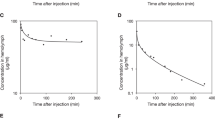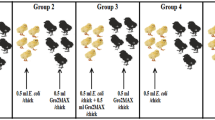Abstract
The increasing clinical incidence of antibiotic resistance in bacteria is a major global health care issue. Rampant use of antimicrobials is one of the major reasons of the dramatic rise in antibiotic-resistant bacterial strains. Suitable animal models are required to improve our understanding of bacterial pathogenicity, evolution and search for novel antibiotics. The larvae of the silk moth (commonly called silkworm), Bombyx mori, have been used as an animal model for testing the pathogenicity of a clinically isolated strain of enterohemorrhagic Escherichia coli O157:H7 upon injection through hemolymph. Here, we show that a foodborne E. coli O157:H7 strain can kill silkworm larvae upon injection through either hemolymph (blood) or midgut. Bacterial number in the hemolymph started to increase after 3 h of injection into hemolymph, while the number of viable circulating hemocytes decreased. Administration of four well-known antibiotics into the larval hemolymph up to 100 µg per larva showed therapeutic effect with varying efficacies against E. coli O157:H7 with ceftriaxone and imipenem showing better effect. Our findings indicate that silkworm larvae can be used as an animal model to screen for novel antibiotics that are effective against E. coli O157:H7.





Similar content being viewed by others
Data Availability
Data and material are available upon request.
References
Kaper JB, Nataro JP, Mobley HL (2004) Pathogenic Escherichia coli. Nat Rev Microbiol 2:123–140
Lim JY, Yoon JW, Hovde CJ (2010) A brief overview of Escherichia coli O157:H7 and its plasmid O157. J Microbiol Biotechnol 20:5–14
Nguyen Y, Sperandino V (2012) Enterohemorrhagic E. coli (EHEC) pathogenesis. Front Cell Infect Microbiol 2:90
Piérard D, De Greve H, Haesebrouck F, Mainil J (2012) O157:H7 and O104:H4 Vero/Shiga toxin-producing Escherichia coli outbreaks: respective role of cattle and humans. Vet Res 43:13
Mir RA, Kudva IT (2019) Antibiotic-resistant Shiga toxin-producing Escherichia coli: an overview of prevalence and intervention strategies. Zoonoses Public Health 66:1–13
Munns KD, Selinger LB, Stanford K, Guan L, Callaway TR, McAllister TA (2015) Perspectives on super-shedding of Escherichia coli O157:H7 by cattle. Foodborne Pathog Dis 12:89–103
Rahman MA, Rahman AKMA, Islam MA, Alam MM (2017) Antimicrobial resistance of Escherichia coli isolated from milk, beef, chicken meat in Bangladesh. Bangl J Vet Med 15:141–146
Karmali MA (2018) Factors in the emergence of serious human infections associated with highly pathogenic strains of shiga-toxin producing Escherichia coli. Int J Med Microbiol 308:1067–1072
Mead PS, Slutsker L, Dietz V, McCaig LF, Bressee JS, Shapiro C, Griffin PM, Tauxe RV (1999) Food-related illness and death in the United States. Emerg Infect Dis 5:607–625
Melton-Celsa AR, O’Brien AD (2014) New therapeutic developments against Shiga-toxin producing Escherichia coli. Microbiol Spectr 2(5):13–2013
McGannon CM, Fuller CA, Weiss AA (2010) Different classes of antibiotics differentially influence Shiga toxin production. Antimirob Agents Chemotherap 54:3790–3798
Smith KE, Wilker PR, Reiter PL, Hedican EB, Bender JB, Hedberg CW (2012) Antibiotic treatment of Escherichia coli O157 infection and the risk of hemolytic uremic syndrome, Minnesota. Pediatr Infect Dis J 31:37–41
Kimmit PT, Harwood CR, Barer MR (2000) Toxin gene expression by Shiga-toxin producing Escherichia coli: the role of antibiotics and the bacterial SOS response. Emerg Infect Dis 5:458–465
Kurioka T, Yunou Y, Harada H, Kita E (1999) Efficacy of antibiotic therapy for infection of Shiga-like toxin-producing Escherichia coli O157:H7 in mice with protein-calorie malnutrition. Eur J Clin Microb Infec Dis 18:561–571
Ochoa TJ, Chen J, Walker CM, Gonzales E, Cleary TG (2007) Rifaximin does not induce toxin production or phage-mediated lysis of Shiga-toxin producing Escherichia coli. Antimicrob Agents Chemother 51:2837–2841
Ermolaeva MA, Schumacher B (2014) Insights from the worm: the C. elegans model for innate immunity. Semin Immunol 26:303–309
Boyer L, Paquetta N, Silverman N, Stuart LM (2012) Bacterial effectors: learning on the fly. Adv Exp Med Biol 710:29–36
van der Sar AM, Applemelk BJ, Vandenbroucke-Grauls CM, Bitter W (2004) A star with stripes: zebrafish as an infection model. Trends Microbiol 12:451–457
Kaito C, Akimitsu N, Watanabe H (2002) Sekimizu K (2002) Silkworm larvae as an animal model of bacterial infection pathogenic to humans. Microb Pathog 32:183–190
Kaito C, Kurokawa K, Matsumoto Y, Terao Y, Kawabata S, Hamada S, Sekimizu K (2005) Silkworm pathogenic bacteria infection model for identification of novel virulence genes. Mol Microbiol 56:934–944
Miyashita A, Iyoda S, Ishii K, Hamamoto H, Sekimizu K, Kaito C (2012) Lipopolysaccharide O-antigen of enterohemorrhagic Escherichia coli O157:H7 is required for killing both insects and mammals. FEMS Microbiol Lett 333:59–68
Saha SS, Suzuki J, Uda A, Watanabe K (2017) Silkworm model for Francisella novicida infection. Microb Pathog 113:94–101
Hossain MS, Hamamoto H, Matsumoto Y, Razanajatovo IM, Larranaga J, Kaito C, Kasuga H, Sekimizu K (2006) Use of silkworm larvae to study pathogenic bacterial toxins. J Biochem 140:439–444
Matsumoto Y, Sekimizu K (2019) Silkworm as an experimental animal for research on fungal infections. Microbiol Immunol 63:41–50
Usui K, Miyazaki S, Kaito C, Sekimizu K (2009) Purification of a soil bacteria exotoxin using silkworm toxicity to measure specific activity. Microb Pathog 46:59–62
Hamamoto H, Kurokawa K, Kaito C, Kamura K, Razanajatovo IM, Kusuhara H, Santa T, Sekimizu K (2004) Quantitative evaluation of the therapeutic effect of antibiotics using silkworms infected with human pathogenic microorganisms. Antimicrob Agents Chemother 48:774–779
Hamamoto H, Horie R, Sekimizu K (2019) Pharmacokinetics of anti-infectious reagents in silkworms. Sci Rep 9:9451
Tsai CJ, Loh JM, Proft T (2016) Galleria mellonella infection models for the study of bacterial diseases and for antimicrobial drug testing. Virulence 7:214–219
Giannouli M, Palatucci AT, Rubino V, Ruggiero G (2014) Use of larvae of the wax moth Galleria mellonella as an in vivo model to study the virulence of Helicobacter pylori. BMC Microbiol 14:228
CLSI (2018) Methods for dilution antimicrobial susceptibility tests for bacteria that grow aerobically. CLSI standard M07, 11th edn. Clinical and Laboratory Standards Institute, Wayne
CLSI (2013) Performance standards for antimicrobial susceptibility testing. CLSI standard M100–S23. Clinical and Laboratory Standards Institute, Wayne
Cerenius L, Lee BL, Söderhäll K (2008) The proPO-system: pros and cons for its role in invertebrate immunity. Trends Immunol 29:263–271
Eleftherianos I, Revenis C (2011) Role and importance of phenoloxidase in insect homeostasis. J Innate Immun 3:28–33
Browne N, Heelan M, Kavanagh K (2013) An analysis of the structural and functional similarities of insect hemocytes and mammalian phagocytes. Virulence 4:597–603
Ishii K, Adachi T, Hamamoto H, Sekimizu K (2014) Serratia marcescens suppresses host cellular immunity via the production of an adhesion-inhibitory factor against immunosurveillance cells. J Biol Chem 289:5876–5888
Mizerska-Dudka M, Andrejko M (2014) Galleria mellonella hemocytes destruction after infection with Pseudomonas aeruginosa. J Basic Microbiol 54:232–246
Miyashita A, Kizaki H, Kawasaki H, Sekimizu K, Kaito C (2014) Primed immune responses to Gram-negative peptidoglycans confer infection resistance in silkworms. J Biol Chem 289:14412–14421
Zak O, Tosch W, Sande MA (1982) Correlation of antibacterial activities of antibiotics in vitro and in animal models of infection. J Antimicrob Chemother 15:273–282
Karch H, Goroncy-Bermes P, Opferkuch W, Kroll H-P, O’Brien A (1985) Subinhibitory concentrations of antibiotics modulate amount of Shiga-like toxin produced by Escherichia coli. In: Adam D, Hahn H, Opferkuch W (eds) The influence of antibiotics on the host parasite relationship II. Springer, Berlin, pp 230–237
Acknowledgments
This study was funded by the North South University Grant, NSU-RP-18-044 to MSH. The funding agency played no role in the study design, in the collection, analysis or interpretation of data, in the writing of the report, and in the decision to submit the article for publication. We thank Mrinmoy Sarker of the Department of Biochemistry and Microbiology of North South University for technical assistance.
Author information
Authors and Affiliations
Contributions
Experiments were designed and carried out by IIA, MMH, and MSH. Silkworm larvae were reared by MAU. E. faecalis strain was isolated and characterized by MLB. IIA and MSH analyzed the data and wrote the manuscript.
Corresponding author
Ethics declarations
Conflict of interest
None.
Informed Consent
All authors agree with the final version of the manuscript.
Additional information
Publisher's Note
Springer Nature remains neutral with regard to jurisdictional claims in published maps and institutional affiliations.
Rights and permissions
About this article
Cite this article
Ahad, I.I., Hossain, M.M., Uddin, M.A. et al. Therapeutic Effect of Antibiotics Against Escherichia coli O157:H7 in Silk Moth Larvae Animal Model. Curr Microbiol 77, 2172–2180 (2020). https://doi.org/10.1007/s00284-020-02023-1
Received:
Accepted:
Published:
Issue Date:
DOI: https://doi.org/10.1007/s00284-020-02023-1




